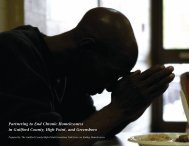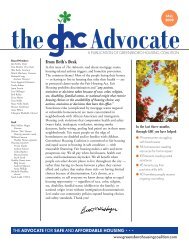data - Greensboro Housing Coalition
data - Greensboro Housing Coalition
data - Greensboro Housing Coalition
You also want an ePaper? Increase the reach of your titles
YUMPU automatically turns print PDFs into web optimized ePapers that Google loves.
sheltered homeless people in numerous categories for 2007 and 2008 and are intended to<br />
supplement the information provided in the body of the report.<br />
1.4 Trends in Homelessness and the Economic Crisis<br />
This first year-to-year comparison of HMIS <strong>data</strong> on sheltered homelessness is of particular<br />
interest because of the economic and foreclosure crisis that began in December 2007.<br />
Changes across the two years provide an early glimpse at the effect of the recession on<br />
homelessness, but the full effect of the economic and foreclosure crisis has yet to be observed<br />
in the AHAR. The <strong>data</strong> collection period for the 2008 AHAR ended on September 30, 2008,<br />
just as the crisis was accelerating, yet the impact of the crisis continues to unfold throughout<br />
the United States. Also, as suggested in this report as well as in other studies, people who are<br />
in jeopardy of losing their homes due to unemployment or foreclosure typically rely on other<br />
housing options before resorting to the shelter system. For example, people often stay with<br />
family and friends until they either regain their financial footing, move to another location, or<br />
become homeless.<br />
Both PIT and HMIS <strong>data</strong> show that, while homelessness remains predominately an urban<br />
phenomenon and most people are homeless as individuals rather than as members of<br />
families, homelessness became more common among families between 2007 and 2008. This<br />
shift is probably related to the economic crisis, although it is unknown if it will persist.<br />
The <strong>data</strong> also show that, in spite of the economic crisis, there was a decline in homelessness<br />
in urban areas (defined as principal cities of metropolitan areas). This drop may reflect<br />
progress communities were making in ending chronic homelessness before the economic<br />
downturn. Chronic homelessness refers to individuals who have experienced repeated<br />
episodes of homelessness or have been homeless for several years. Ending chronic<br />
homelessness has been a national policy objective that has been supported by significant<br />
investments in developing permanent supportive housing. For several years communities<br />
have reported declines in the number of persons experiencing chronic homelessness.<br />
Introduction 5




